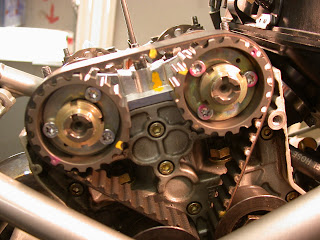 I decided to set it up to see if I could actually check the rake and trail numbers. Above you can see the laser set up to check the vertical line through the center of the axle to the ground. You can barely see the red line in the picture. I've got a T square set up to check the "plumb" of the line.
I decided to set it up to see if I could actually check the rake and trail numbers. Above you can see the laser set up to check the vertical line through the center of the axle to the ground. You can barely see the red line in the picture. I've got a T square set up to check the "plumb" of the line. Close up of the vertical line.
Close up of the vertical line. I previously set the laser to follow along the centerline of the forks then moved it back to the centerline of the steering head, I confirmed the position by measuring back 27mm (the offset of the clamps) at the axle point. Then I marked the point where it hit the ground (actually a board under the tire to make up for the height of the stand) this is where the rake angle is.
I previously set the laser to follow along the centerline of the forks then moved it back to the centerline of the steering head, I confirmed the position by measuring back 27mm (the offset of the clamps) at the axle point. Then I marked the point where it hit the ground (actually a board under the tire to make up for the height of the stand) this is where the rake angle is. To get the trail number I measured the distance between the two points marked on the board. And to my surprise I got 99mm, which is exactly what was quoted in the geometry figures I have, and what I calculated it would be working with the 27mm clamps.
To get the trail number I measured the distance between the two points marked on the board. And to my surprise I got 99mm, which is exactly what was quoted in the geometry figures I have, and what I calculated it would be working with the 27mm clamps.So, overall, I'm happy I took the time to play around with the laser...Hey, it's no Computrack system, but it was nice to see how the geometry works when making changes. AND I like playing around with this stuff....Yeah, I know, I got way too much time on my hands!!!



 While I had the front end apart I made some adjustments to the fairing stay so that the dash sat higher and angled back more, leaving more room for the throttle cables to run underneath.
While I had the front end apart I made some adjustments to the fairing stay so that the dash sat higher and angled back more, leaving more room for the throttle cables to run underneath.


















 Got 'em set to 107-107.
Got 'em set to 107-107.

























